Integrated Applied Mathematics Alumni
We enjoy connecting and hearing from the IAM alumi community, and we hope you stay in touch.
UNH Connect – The Online Community for UNH Alumni and Friends.
Wildcat Connections – The online community for students and alumni to come together and share experiences.
If you would like to be featured in the Alumni Spotlight section below, or if you would like to participate in the IAM Seminar Series or give a presentation, please contact Tracey Harvey.
Integrated Applied Mathematics Alumni Spotlights

Brandon is a postdoc working with Professor Georgy Manucharyan at the University of Washington. At UNH he worked with Professor Greg Chini and his dissertation focused on a new large-Reynolds number asymptotic analysis of the Navier-Stokes equations, defining a new multiple spatial scale self-sustaining process for observed structures in the instantaneous velocity profile. At the University of Washington, his research utilizes applied mathematics to investigate the underlying physics of arctic sea ice. The multi-scale nature of sea ice presents a challenge for developing realistic models capable of simulating individual floes and fractures. Brandon is currently part of a multi-university research initiative whose overarching goal is to develop an improved mathematical framework for sea ice prediction from synoptic to pan-Arctic scales, which will fill the gap in their quantitative understanding of its evolution as a multiscale medium. Thus enabling the development of the next-generation sea ice prediction systems. Brandon’s part of this project is creating a sea ice model utilizing a discrete element method to resolve interactions and phenomena at the floe-scale. Outside of school, Brandon enjoys taking advantage of the extensive wilderness in the Pacific northwest through skiing, hiking and trail running.
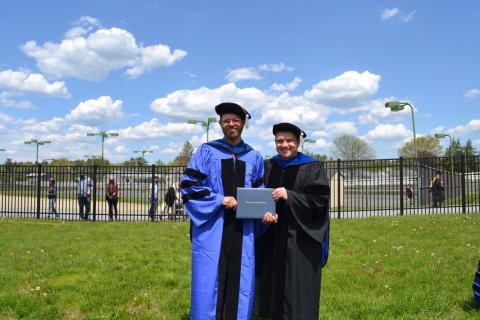
Brandon Montemuro & Prof. Chini at UNH 2020 Graduation Celebration

Baole Wen is an assistant professor in the Department of Mathematics. Before joining New York Institute of Technology in 2022, he had been a postdoctoral assistant professor of mathematics at the University of Michigan and a Postdoctoral Fellow in the Oden Institute for Computational Engineering and Sciences at the University of Texas at Austin. Baole received his Ph.D. in Applied Mathematics from the University of New Hampshire in 2015. His research advisor at UNH was Prof. Greg Chini.
His Ph.D. research was focused on understanding the underlying flow and transport mechanisms governing the spatiotemporally-chaotic system of porous medium convection at large Rayleigh numbers. He obtained a master's degree in fluid mechanics and a bachelor's degree in engineering mechanics from Beijing University of Aeronautics and Astronautics in 2010 and 2007, respectively.
Baole's research interests cover broad areas of applied and computational mathematics, including fluid mechanics, mathematical modeling, PDE-constrained optimization, scientific computing, model order reduction, efficient numerical algorithms, and pattern formation and nonlinear dynamics in high-dimensional spatiotemporal dynamical systems. To conduct his research, Baole employs direct numerical simulations, high-performance computing, variational and stability analyses, optimization, dynamical system theory, and experimental validation.
Laura received her PhD from the IAM program in 2017 under the supervision of Dr. James Pringle. Laura’s dissertation research focused on chaotic dynamics in spatially explicit population models with differing dispersal scenarios.
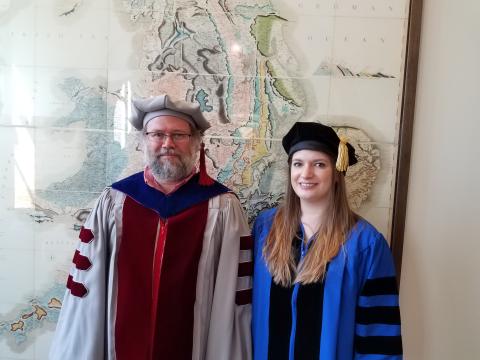
Prof. James Pringle (Adviosr) and Laura Storch on graduation day.
From 2017 to 2019 Laura was a postdoc for Dr. Sarah Day at William & Mary and conducted research in using topological data analysis to quantify pattern changes of spatially explicit populations undergoing a critical transition. From 2019 to 2022 Laura was a postdoc at Oregon State University’s Hatfield Marine Science Center with Dr. Will White, using statistical population models to determine the effects of extreme climate on oyster population recovery.
In her current position as an Assistant Professor at Bates College, Laura continues her collaborations with Dr. White and Dr. Day and remains primarily interested in using mathematics to inform environmental conservation and management strategies. In her spare time she’s getting reacquainted with the mountains of New England and the beauty of “leaf peeping” season (and realizing that professors have even less spare time than postdocs).

Laura Storch during a hike in the Idaho mountains
John holds the position of Postdoctoral Associate within the Department of Mathematics at the University of Pittsburgh, where he conducts research under the guidance of Dr. Jonathan Rubin. His current postdoctoral pursuits are concentrated in the realm of mathematical neuroscience, with a primary focus on the development of a dynamical model pertaining to a subregion of the basal ganglia, namely, the Substantia Nigra pars reticulata (SNr). Within the project, John is seeking to unravel the nuanced responses of SNr neurons to optogenetic stimulation of inhibitory input regions. Additionally, this research delves into the intricate alterations in these neuronal responses within a simulated model of Parkinson's Disease, characterized by dopamine depletion, as observed in rodent subjects. His research is largely informed from experimental data gathered from collaborators at Carnegie Mellon University. John's role within this interdisciplinary project is centered around data-driven tuning of the model, simulations, and analytical facets. Notably, he has recently devised a novel analysis software designed to robustly classify spike train responses in contrast to a baseline period in a user-friendly manner.
During his graduate studies at the University of New Hampshire (UNH), John completed his PhD with a specialization in nonlinear dynamics and chaos, under the mentorship of Dr. Kevin Short. His doctoral thesis represented a unique fusion of chaos theory and mathematical neuroscience, elucidating the intricate control mechanisms that enable the manipulation of neuron models operating within chaotic parameter regimes, particularly through interactions of "cupolets" (chaotic unstable periodic orbit-lets). This work has continued since completing his dissertation resulting in several published articles.
Outside of work, John enjoys traveling with his partner (also a graduate of the IAM PhD program), trying different foods, and spending time with his cats.

John enjoying two Icelandic style hot dogs in Reykjavík.
For more information on John’s career feel free to peruse his website. John is happy to connect with potential and current IAM students to provide insight and perspective on his experience in the IAM program as well as being in academia as a graduate student and postdoc. He can be reached at john.parker@unh.edu or jep220@pitt.edu.
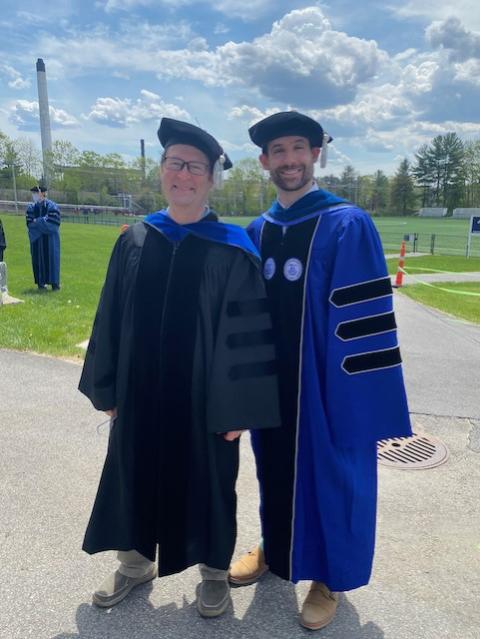
John and Dr. Kevin Short after the UNH 2021 graduation ceremony.
Madeline currently serves as a Postdoctoral Associate within the Department of Neuroscience at the University of Pittsburgh, working under the mentorship of Dr. Chengcheng Huang. Her primary research endeavors involve the analysis of an exponential integrate and fire spiking neuron model encompassing three distinct inhibitory population cell types. This collaborative effort extends to experimental laboratories investigating the intricate interplay of memory, learning, and attention-queued tasks. In her ongoing research, Madeline's principal objective is to elucidate the dynamics of individual synaptic connections and inhibitory populations, thereby contributing to a profound understanding of the mechanisms governing asynchronous neural activity. The methodology employed involves a judicious combination of simulated data sets generated from the spiking model and analysis of linearized systems of Ordinary Differential Equations (ODEs) to effectively quantify neural activity.
Previously, Madeline held the position of NIH T32 Postdoctoral Scholar at the University of Pittsburgh within the Department of Neuroscience and Neurobiology from August 2021 to August 2023, where she delved into the impact of stroke on neural activity. Her work in this capacity utilized the spiking neural model to probe alterations in network structure analogous to maladaptive stroke outcomes. Having successfully completed the T32 program in August 2023, Madeline was invited to continue her work in neural models under the guidance of Dr. Huang.
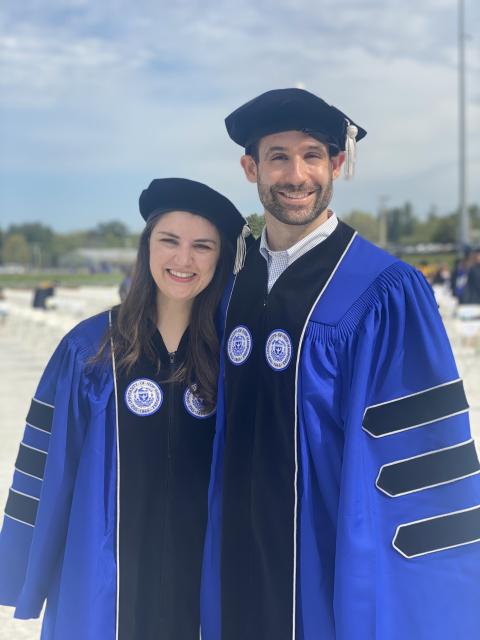
Madeline with her partner, John Parker.
Madeline earned her PhD in May 2021 at the University of New Hampshire with a specialization in nonlinear dynamics and chaos. Under the mentorship of Dr. Marianna Shubov, her thesis topic centered around analytical Partial Differential Equations (PDEs), complex analysis, and stability analysis within the context of fluid flow through flexible tubes experiencing small perturbations. This research was rooted in the physical application of blood flow through small blood vessels. From both her work as a graduate student and postdoctoral experiences, Madeline’s expertise extends in both theoretical and applied domains of neuroscience and fluid dynamics with applications to biology.

Outside of research, Madeline enjoys hiking and walks in nature which provide inspiration for her floral gouache paintings. She enjoys spending time with her partner and their two cats, Todd and Murphy.
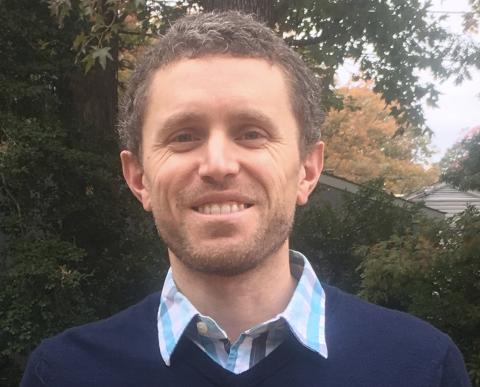
Matt was the first doctoral graduate of UNH’s IAM program in 2014. He completed his dissertation under the supervision of Dr. Kevin Short, with whom he continues to collaborate. Their research focuses on nonlinear and chaotic systems, with particular emphasis on cupolets (accurate approximations of unstable periodic orbits) and mutual stabilization, previously known as chaotic entanglement. Their work has led to multiple peer-reviewed publications, three U.S. patents, and presentations at conferences in the U.S., Scotland, and Portugal.
Matt credits the IAM program with shaping both his research trajectory and teaching philosophy. While at UNH, he gained formative experience as a teaching assistant, sole instructor for undergraduate calculus, and lead researcher on several privately funded grants. He received both the Dissertation Year Fellowship and the Summer Teaching Assistant Fellowship, two of UNH’s most competitive graduate awards.
He now teaches at Christopher Newport University (CNU), a public liberal arts institution in Newport News, VA, where he is a tenured Associate Professor of Mathematics. Over the past decade, he has mentored dozens of undergraduate students on projects in mutual stabilization, computational neuroscience, machine learning, biostatistical modeling, and fractals. Many have gone on to pursue graduate study in applied and computational mathematics.
At CNU, Matt teaches a wide range of courses, from introductory classes for non-majors to advanced seminars on nonlinear differential equations and chaos. He is a Project NExT fellow, a recipient of CNU’s Faculty Excellence Award in Teaching, and the 2025 recipient of the John M. Smith Award for Distinguished College or University Teaching from the Mathematical Association of America’s MD-DC-VA section.

Outside of academics, Matt enjoys hiking in the Blue Ridge Mountains, going to the beach, traveling with friends and family, and keeping up with the joyful chaos of raising two young children.
He can be reached at: https://matthew-morena.github.io/